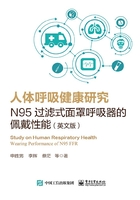
03 Chapter 3 Studyofparticlerebound03anddepositiononfibersurface
◆ Introduction
◆ Models of flow field and particle movement
◆ Particle transport and deposition
◆ Conclusion
Fibrous filters,which are the most commonly used means of particle filtration,are generally characterized by the air pressure drop and filtration efficiency.The nature of particle movement and interaction between the particle and fiber is of great importance for measuring the filtration efficiency of fibrous filters.Majority of previous studies investigated particle trajectory and deposition using the ideal trapping model,which assumed that particles will be trapped once contacted with a solid surface (fiber or deposited particle).This chapter investigates the dynamic performance of particle rebound and statistically analyses the deposition/accumulation of particles on a fiber surface.We use the computational fluid dynamics method to calculate the flow field around a row of fibers.Then,we utilize a particle adherence and rebound criterion and simulate the particle trajectory and deposition using a self-developed solver in Fortran code.Effects of face velocity,particle diameter and particle rebound characteristics on particle rebound and accumulation around one of the fibers are investigated.Additionally,the trajectories and accumulation of particles on the fiber surface are visually presented.Finally,the filtration efficiency of a single fiber is compared with published results.It is found that effects of particle rebound on the particle trajectory and deposition are significantly related to the face velocity and particle diameter.With considering the particle rebound,the filtration efficiency of a single fiber is obviously different from those of previous studies.